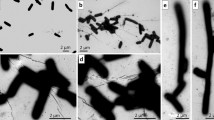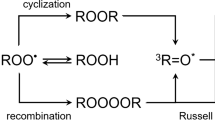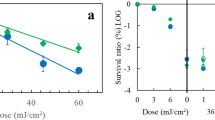Abstract
STRUGGER1, one of the pioneers who introduced acridine orange as a biological fluorochrome, observed that dead cells take up more of this dye, and under ultra-violet excitation fluoresce red, whereas living cells take up less dye and fluoresce green. This difference in the fluorescence is often used as a test for viability of cells and is referred to as ‘Strugger effect’2. Loss of viability associated with red fluorescence has also been confirmed by Krebs and Gierlach3 in their work involving radiobiological action on Allium cepa cells. Later work has shown that green acridine orange fluorescence in normal cells is to be associated with cell constituents rich in deoxyribonucleic acid4. It is also known from the observations of Beers et al. 5, Bradley and Wolf6, and Ranadive and Korgaonkar7, that deoxyribonucleic acid can form two complexes with acridine orange. One of these complexes is formed when the relative concentration of acridine orange to deoxyribonucleic acid is low, and exhibits strong green fluorescence and the other occurs when this ratio is high and shows orange or red fluorescence. Shift of fluorescence from green to orange is a critical step in this transition, whereas further change from orange to deep red is not sharp and occurs with further increase in concentration of acridine orange, without involving formation of new complexes. ‘Strugger effect’ may be explained in terms of these observations as a kind of damage to structures rich in deoxyribonucleic acid in the inactivated cells. This results in their high uptake of acridine orange to such an extent that the corresponding fluorescence is copper red. Few observations, however, are available to indicate the nature and extent of damage near the critical point when the shift of fluorescence from green to orange just occurs. A study of this nature in relation to viability was carried out by us on E. coli using ultrasonic waves for irradiation and the findings are reported here.
This is a preview of subscription content, access via your institution
Access options
Subscribe to this journal
Receive 51 print issues and online access
$199.00 per year
only $3.90 per issue
Buy this article
- Purchase on Springer Link
- Instant access to full article PDF
Prices may be subject to local taxes which are calculated during checkout
Similar content being viewed by others
References
Strugger, S., Fluoreszenmicroscopie und microbiologie (M. and H. Shaper, Hanover, 1949).
Everson-Pearse, A. G., Histochemistry, 732 (J. and A. Churchill, London, 1960).
Krebs, A. T., and Gierlach, A. Z., Amer. J. Roent. and Rad. Therapy, 65, 1, 93 (1951).
Armstrong, J. A., Exp. Cell. Res., 11, 640 (1956).
Beers, R. F., Hendley, D. D., and Steiner, R. F., Nature, 182, 242 (1958).
Bradley, D. F., and Wolf, M. K., Neuro-chemistry of Nucleotides and Amino Acids, 89 (John Wiley and Sons, Inc., 1960).
Ranadive, N. S., and Korgaonkar, K. S., Biochim. Biophys. Acta, 39, 547 (1960).
Author information
Authors and Affiliations
Rights and permissions
About this article
Cite this article
RANADE, S., TATAKE, V. & KORGAONKAR, K. Effects of Ultrasonic Radiation in Escherichia coli B using Fluorochrome Acridine Orange as a Vital Stain. Nature 189, 931–932 (1961). https://doi.org/10.1038/189931a0
Issue Date:
DOI: https://doi.org/10.1038/189931a0
This article is cited by
-
Vidyadhar Govind (Pandit) Tatake (1926–2004): An ingenious instrumentalist, an authority on thermoluminescence, and a lover of classical Indian music
Photosynthesis Research (2006)
-
Comparative study of phagocytosis and intracellular bactericidal activity of human monocytes and polymorphonuclear cells
Inflammation (1988)
Comments
By submitting a comment you agree to abide by our Terms and Community Guidelines. If you find something abusive or that does not comply with our terms or guidelines please flag it as inappropriate.



